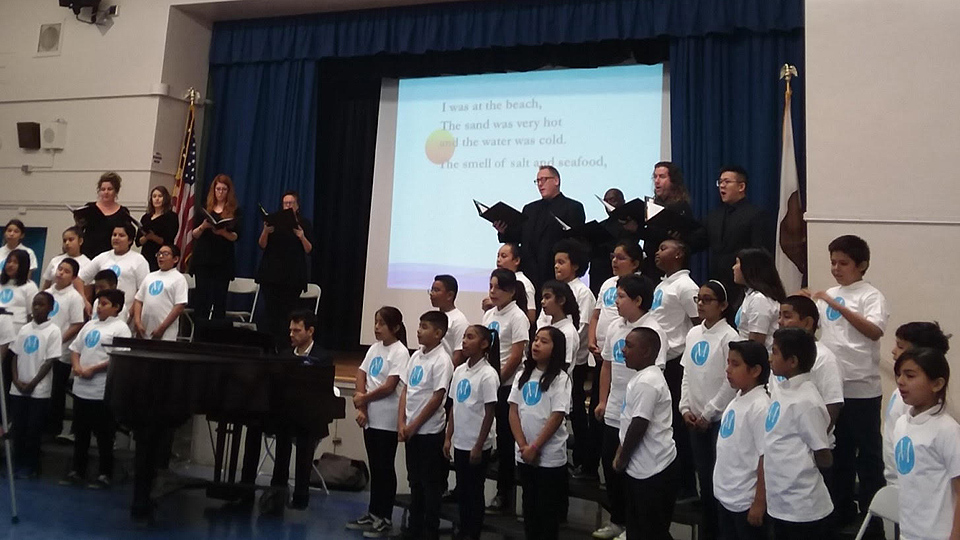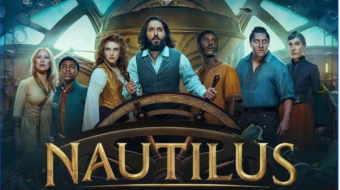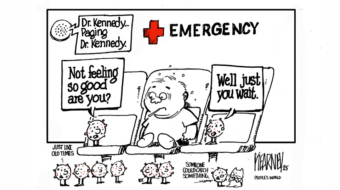
LOS ANGELES—Early last year a press release from the Los Angeles Master Chorale (LAMC) came my way about high school kids in Van Nuys writing and performing a new oratorio on the theme of the Japanese American internment camps during World War II. Curious to see what they might come up with, I checked it out and found it a moving experience that was also documented by PBS.
The high school oratorio program is only one school outreach program the LAMC does. This year I checked out another, the Voices Within program, which equally engages the students not only in the musical and literary arts, but also in history and other interdisciplinary subjects. LAMC followed the same general principle of bringing three teaching artists—a performer, a composer and a lyricist—into the schools to introduce the students to musical ideas such as pitch, rhythm and melody, to successful performance practices, and to the skill of songwriting.
In a fifth-grade program at the Hooper Avenue Elementary School on E. 52nd St. in South Los Angeles, students took on the theme of math and science in their 12-week session.
A second simultaneous program at the Carlos Santana Arts Academy in North Hills took on the theme of “Opening Doors,” inspired by the school’s focus on preparing students for college. The songs they wrote and performed were based on topics of self-awareness, self-management, growth mindset, social awareness, relationship skills, passion and inspiration.
I attended the Fri., Nov. 16th 10:00 am performance at Hooper. With the introductions and the viewing of a short documentary film about the program, the performance lasted just over an hour. A second performance took place immediately after for family members, friends, funders and other invited guests.
LAMC sets up some “rules of collaboration” for the process. They encourage participants to work with fellow students they may not know very well and to behave as if your team is made up of your best friends. Students from two fifth-grade classrooms are encouraged to share their ideas and feelings during the songwriting process to ensure that the whole group takes ownership of the resulting work. No one’s input is to be dissed: Respect and collaboration are the assignment. They are asked to “Be brave!” and “Just say yes!” Each song is the product of a team of about ten kids.
The three teaching artists working with the Hooper Avenue students were performer Amy Fogerson, a singer with LAMC who conducted the performance, lyricist Brett Paesel, and composer Michael Alfera, who accompanied on piano. The participating classroom teachers were Jasmine Davis and Margaret Stewart.
For the performance LAMC also supplied eight professional singers—four women and four men—from the 100-strong chorale as backup to the unison children’s voices, so that harmonies and rhythmic interest could be unobtrusively introduced by the professional composer for a fuller, richer sound.
The 65 participating students were almost all from Latin American cultures, with a minority admixture of African-American kids, a reflection of the profound demographic shift in South L.A. over the past few decades. Bilingual announcements were made whenever possible. The LAMC singers were also ethnically mixed to some degree.
The concert began with an opening number performed by the eight LAMC soloists, an upbeat, polyrhythmic arrangement of “Battle of Jericho,” displaying mastery of complex choral writing and a wide range of sound from gospel-sized high soprano to thundering low bass. It’s quite possible that the students had never heard what magic a few professional voices can manufacture in thin air.
The students came up with six songs on the subject of black holes, fractions, gravity, tides, the universe, and zero. Far from didactic explanations of these topics, the songs turned out to have a lot of lovely kids’-eye poetry in them. The expansiveness of their young thinking, applying concepts to experiences in their own lives and obviously taking some ideas from story books and visual media, truly impressed.
From Zero to Infinity: Songs about Math and Science communicated real feelings and emotions, as some of the lyrics quoted below will show. The sentiments and intelligence expressed in these songs favorably compare to much of the pop music we hear. Musically the tone was generally a pop idiom with comfortably fitting harmonies. The children had the songs all memorized. I felt honored to be part of the world premiere audience.
“Once Upon a Time in Fraction Village” is written in waltz time, a musical reminder that fractions can involve both odd and even numbers:
We live in Fraction Village,
Our walls are full of numbers and colors,
We use math to divide things equally
With our rulers and our pencils and our books
Some of us look like numbers,
And we have pets that look like equals and pluses and minuses.
CHORUS
Fractions are cool. Fractions are easy.
They help me cut a chocolate cake,
They help me slice a pepperoni pizza.
My confusion floats away on a cloud into a beautiful sky of numbers.
Everybody loves fractions.
The village is one-half the size of the castle.
Half the wall is white,
Half the wall is black.
In the castle Queen Eleven-Twelve counts money.
She uses fractions to make potions,
She wears a red dress and a crown.
Her face is half nice,
and half evil.
“Nothing Land” is inspired by the concept of zero. One of the ancient peoples who independently invented zero were the Maya of Central America, and one of the songwriters was named Kelvin Maya! The song ranges far from the mathematical into an almost Samuel Beckett-like existentialist dreaming. I wondered if it in any way characterized these kids’ lives as migrants, or children of migrants in a new land.
I was in the mini market,
There was lots of food,
But no one was there.
It was like it was abandoned like a big zero,
I felt nothing.
CHORUS
Zero is a placeholder
like a carrot on a chair,
a cake next to a bird,
I’m lonely and confused
in a forest of zeros.
I went to the desert and saw my brother,
He was alone and he had nothing.
He had no expression on his face.
I ran toward him and I stopped,
I tasted sand and saw that it was a mirage. CHORUS
There’s no light in the darkness,
The world’s color is a blank wall.
It was like it was abandoned like a big zero, I felt nothing. CHORUS
“Ready To Go into Space,” inspired by black holes, reveals familiarity with television shows and films. It exteriorizes the kids’ fears of danger and risk, while also embracing mystery and exploration.
I was born ready to go into space,
But I can tell you:
If you take a spaceship into a
black hole don’t get sucked in.
It’s as small as the tip of a pencil or an ant.
But don’t get sucked in
CHORUS
How high is a black hole?
Is it dangerous?
I’m nervous and curious,
And I can’t move my body.
Shivers go down my spine.
Will it take me to a new world?
When my ship gets close,
The black hole sounds like a thunderstorm,
And feels like rain drops,
It’s stronger than light
But I’m going to be at risk,
I might disintegrate like a piece of garbage,
It’s too late it’s too hard,
If I don’t get out I might never get home. CHORUS
When my ship gets close,
The black hole is so strong,
And I’m scared and about to cry.
My body is stretching apart, stretching apart,
I use full speed and I survive,
Put it reverse, fast!
If there was a suggestion of anxiety in that song, the next, “Waves in the Ocean,” inspired by tides, had a quieting effect. I wondered if part of the assignment might have been a field trip to the Pacific Ocean: Some kids growing up in the city have never seen it.
I was at the beach,
The sand was very hot and the water was cold.
The smell of salt and seafood,
I heard waves hitting the rocks.
The breeze was like a whisper
or a lullaby.
It sounded so beautiful.
CHORUS
The ocean goes high, the ocean goes low.
The movement of the tides makes me feel relaxed
Peace and calm and science
Life moving back and forth in the waves….
After a while the tide got lower,
I watched the crabs walking across the sand.
The water makes you feel like you’re moving.
The sky turned teal, reflecting the water
Cold and shivering I sat on a rock letting the wind ruffle my hair.
At night I like seeing the stars and the moon at the same time. CHORUS
In this song I noticed a youngster named Ricardo Araujo standing on a riser stage left. He moved his hands as if he were signing the lyrics and continued doing so in other numbers as well. Did he learn signing at home perhaps? Did he see it somewhere and feel drawn to imitate it? Was it just spontaneous behavior of untraceable origin? He was very expressive and I enjoyed watching him as I listened.
Kids are probably the first surrealists, the things they imagine! The fifth song in the suite was “Gravity Falls Up.” Someone had clearly mentioned Newton.
I felt a cold breeze go by.
The wind pushed us in the air.
We started floating in space.
We moved faster and slower at the same time.
This will be disaster
CHORUS
Gravity beach, gravity ocean,
Zero gravity is scary fun for everyone,
I scream with joy,
I scream with terror.
I looked up and saw benches from the park were floating.
A dog flew by.
A water slide threw people high into the sky,
And the water turned into a cloud in the air. CHORUS….
I wanted to touch the ground again,
And all of a sudden an apple from a tree fell hard upon my head!
Everything that was up fell down
Gravity was back!
“Big Lonely Universe” brings us up and out to the moon, the Milky Way and beyond. The future is full of possibility and potential as people grow and find their place in the universe. This song, like the others, embraces secular science. I was glad to see no intrusion of “intelligent design” that possibly some kids are exposed to at home or in church.
I heard a strange sound,
A rooster crowing
to wake up the moon,
I strolled through the
Milky Way and picked up the moon,
I never want to let it go.
CHORUS
We are all beautiful stars
Sparkling silver,
Crashing planets,
The universe feels cold.
It looks black and empty,
But life is hidden away.
I was walking on a planet,
I saw darkness, then it filled with light.
The universe was quiet as a library,
I’ll never forget that feeling.
Magical and exciting. CHORUS
In each of us there are atoms
that were once part of the star
that exploded billions of years ago.
Like a shattering vase.
I feel like I’m being
sucked into the future,
It is cool and scary at the same time.
I hope the stars never stop twinkling. CHORUS
If Los Angeles Master Chorale were to engineer these songs into professionally produced recordings, I bet they’d have a best-seller on their hands!
The printed program listed almost twenty foundations, trusts, funds and public entities that support the Voices Within program. It is a very valuable endeavor worth supporting—that at the same time points up how dependent the arts, and even much of our educational system, are on the private sector, and also how vulnerable to fluctuations in the market, to changing priorities for funding, and possibly to political pressure. Certainly our country is getting no helpful messaging from our Department of Education headed up by Trump crony Betsy DeVos. Our kids everywhere deserve these programs. We celebrate the ones we have and must commit to making them available to all.
The Voices Within video that screened at the show is well worth seeing.










